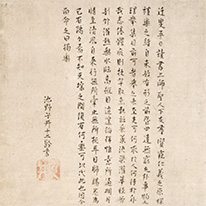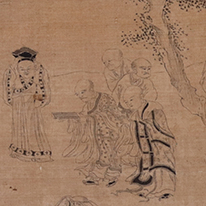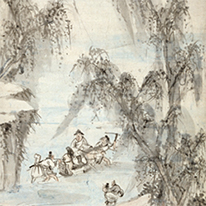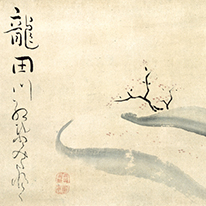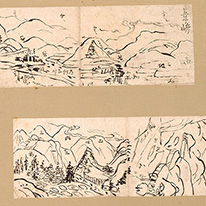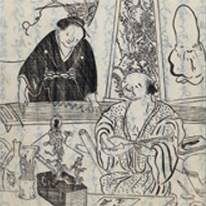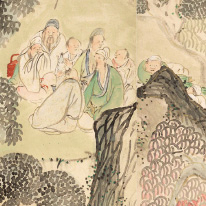General Information
| Exhibition Title | Special Exhibition The Genius of Ike no Taiga: Carefree Traveler Legendary Painter |
|---|---|
| Period | April 7 - May 20, 2018 |
| Venue | Kyoto National Museum Heisei Chishinkan Wing |
| Transportation | JR, Kintetsu Railway, Keihan Railway, Hankyu Railway, City Bus |
| Special Exhibition Hours | 9:30 a.m.-6:00 p.m. (Entrance Until 5:30 p.m.) Fridays, Saturdays 9:30 a.m.-8:00 p.m. (Entrance Until 7:30 p.m.) |
| Closed | Mondays *Closed Mondays, but open Mon. April 30 and closed Tue. May 1. |
| Special Exhibition Admission | Adult 1,500 yen (1,300 yen) Univ. Student 1,200 yen (1,000 yen) High School Student 900 yen (700 yen) Admission is free under middle school students. *(Fees in parentheses for groups of twenty or more) |
| Organized by | Kyoto National Museum, The Yomiuri Shimbun |
| With the support of | SHIMIZU CORPORATION, DAIWA HOUSE INDUSTRY CO., LTD., Nozaki Insatsu Shigyo Co., LTD., Non-Destructive Inspection Co., Ltd. |
| With the cooperation of | Nippon Kodo Co., Ltd. |
Images from the Exhibit
Eighteenth century Kyoto produced some of the most distinctive and original painters in Japanese history, including big names such as Maruyama Ōkyo (1733–1795) and Itō Jakuchū (1716–1800). But even amongst this star-filled lineup, the artist Ike no Taiga (1723–1776), stands with fellow painter Yosa Buson (1716–1783) as the leader of the Chinese-influenced literati style of painting known as Nanga (“Southern painting”). Taiga's works are done in a brisk, unfettered style said to exemplify the artist's generous, humble character and indifference to fame and fortune.
This major exhibition covers Ike no Taiga's long career from his earliest trials through his mature works, giving a comprehensive picture of his lifelong career as an artist. In addition to these paintings, the exhibition will introduce materials showing Taiga's broad social interactions, and revealing the delightful, freewheeling personality that was Ike no Taiga. One more feature of this exhibition is the focus on Taiga's extensive travels throughout Japan as an itinerant painter and the influence of these wanderings on his artistic output.
Part I The Debut of a Genius: Taiga and His Contemporaries
Ike no Taiga (1723–1776) was born the son of a lower-ranking official of the silver mint in Kyoto.
Taiga lost his father while still a young child, and at the age of seven he began to study calligraphy. He immediately displayed a conspicuous talent, inspiring Kōdō Genchō (1663–1733), the 12th abbot of Manpuku-ji temple, to praise him as a “supernaturally gifted child.” No calligraphy by the seven-year old Taiga remains, but An Account of the Garden for Solitary Pleasure (13), written when he was twelve, displays skill with the brush far beyond his years.
The fifteen-year old Taiga made a living selling fans at his shop at Nijō Hinokuchi-chō (east of Kawaramachi-Nijō in today's Kyoto). He used picture books imported from China to provide models for his painted fans; but there were times when, after traveling long distances, he would return without having sold a single fan. Taiga was supported in his teens by those who could appreciate his art. Yanagisawa Kien (1703–1758), a chief advisor for the Yamato Kōriyama domain, recognized Taiga's talent early on and supported him both materially and spiritually. Furthermore, when he was nineteen years old, Taiga met the seal carver Kō Fuyō (1722–1784) and the calligrapher Kan Tenju (1727–1795), two men who were to become his lifelong friends.
The fact that Taiga was a genius of rare talent is undeniable, but it was also encounters with these kinds of people that played an indispensable role in his development into the famous figure recognized by contemporary society.
Part II Learning from Chinese Paintings and Painting Manuals
The young Taiga learned painting techniques from Chinese painting manuals such as Painting Manual of the Mustard Seed Garden (43) and Primer on Eight Varieties of Painting (44).
Painting Manual of the Mustard Seed Garden in particular served as both a source for images and also for theories of painting and techniques, and was utilized as a practical guide to painting.
“An artist must always be aware of the Painting Manual of the Mustard Seed Garden.” As suggested by this assertion in Yanagisawa Kien's Sleeping Alone (Hitorine), the previous, first generation of Japanese Nanga artists before Taiga regularly consulted this work. Taiga himself not only studied pictorial composition from printed works of this sort, but he also incorporated and made practical use of the coloring from the printed images and the sharp lines typical of such printed editions.
At the time, there were few opportunities for ordinary artists (machi eshi) patronized by townspeople to view high-quality Chinese painting; but judging from written sources, we can be certain that Taiga was in fact given access to some of these works. Wang Zhenpeng's scroll of Five Hundred Arhats (51) is a particularly important work with a direct relationship to the creation of Taiga's own Five Hundred Arhats (151), a representative work from his late career.
Taiga's pictorial art approached maturity while he was in his forties; however, works from his twenties—when Taiga attempted to digest and integrate as much visual knowledge as possible—have a unique and distinctive charm of their own.
Part III Finger Painting and the Quest for an Artistic Style
In the latter half of his twenties, Taiga often produced paintings using his fingers and fingernails instead of a brush. The tradition of finger painting (shibokuga or shitōga in Japanese), which came from China, was pioneered in Japan by the literati artist Yanagisawa Kien (1703–1758) as a highly impromptu genre—a sort of improvisational performance art. In fact, using fingers to manipulate the ink greatly restricts one's representational abilities, giving much less freedom of expression than one would have painting with a brush. For that very reason, artists often emphasized the restrictive qualities of such artworks, labeling them in the inscriptions as “finger paintings.”
Taiga, however, discerned a positive significance in the unique qualities of finger painting and incorporated them early on into his own works. Thin lines created by sharpened fingernails, effects created by spreading ink with the palm of the hand (resembling the tarashikomi technique of bleeding wet ink or colors together to create an amorphous layering), and the use of broad, soft, artless lines were some of the techniques that laid the groundwork for Taiga's later style. For this reason, his experimentation with finger painting in his early years was highly significant. Taiga's thirties, when his finger paintings sharply decreased in number, was a period of trial and error as he attempted to master the expressiveness of the brush by capturing elements imbued with a large measure of chance.
For Taiga, inking his fingers was not meant as a performance or a momentary display of eccentricity; instead, finger painting served as an important milestone in the struggle to establish his own mode of artistic expression.
Part IV Taiga's Painting and Calligraphy
Taiga was not only a painter; he was also a renowned calligrapher.
This is exemplified by a famous episode in which, after seeing the boy's calligraphy, the abbot of Manpuku-ji declared the young Taiga to be a “supernaturally gifted child.” In fact before Taiga was ever similarly recognized as a painter, his name was listed as a calligrapher in the 1768 and 1775 editions of Records of Famous Personages in Kyoto (Heian jinbutsushi), a who's who register of Kyoto's cultural elite.
While Taiga's calligraphy was fundamentally based on the then-popular Chinese style, known as karayō in Japanese, its charm resided in its sweeping and elegant brushwork. Taiga, who is said to have operated fan and seal-engraving shops in his youth, was well versed in the various styles used to write Chinese characters, including the archaic seal (tensho) and clerical (reisho) scripts. He not only employed traditional Chinese methods with great facility, but he was ultimately able to go beyond these styles and establish his own creative calligraphy. Taiga also studied classical Japanese poetry (waka) with Reizei Tamemura (1712–1774), who was considered the premier poet in imperial court circles. Taiga left behind a body of calligraphy in the Japanese kana script used to write Japanese poetry. This work is marked by an expansiveness that could be characterized as a generosity of spirit.
From the many extant calligraphic works by Taiga, we have chosen to introduce here a broad scope of Taiga's calligraphy, highlighting in particular those works that successfully harmonize word and image.
Part V Taiga's Journeys: Painting Japanese Scenery
Taiga the painter was an inveterate traveler. He journeyed to Edo (present-day Tokyo) at the age of twenty-six and extended his journey to visit Shiogama and Matsushima, whose beauty dazzled his eyes and captured his imagination. In the following year, he trekked through the Hokuriku area on the Japan Sea side of the main island, and he is also known to have journeyed to Ise and Izumo between the latter half of his twenties and his thirties. Among these many travels, perhaps the most famous is a lengthy trip at age thirty-eight with his friends the seal carver Kō Fuyō (1722–1784) and the calligrapher Kan Tenju (1727–1795), during which they triumphantly reached the summits of the three sacred peaks of Hakusan, Tateyama, and Mount Fuji. Details of this trek can be gleaned from the many sketches included in the folding screen of the Journey to the Three Peaks (111). The result of these travels is marvelously crystalized in True View of Mount Asama (108), which stands out within the entire history of Edo-period painting for its superb representation of the natural world.
Taiga's travels seem to have been inspired by the ideals of Chinese literati painters, who asserted that one could never become a great artist without reading ten-thousand volumes or journeying ten-thousand leagues: He believed that the first-hand experiences gained in his repeated travels were necessary to paint unexcelled landscapes. And, indeed, representations of the natural world derived from actual scenes in various locales, or “true views” (shinkeizu), became a major theme characterizing Taiga's career as a painter. In addition, these experiences had great influence on the sweeping spatial expressiveness that became a rominent element in his work, helping him to establish a personal style in his forties and thereafter.
Part VI Taiga and Gyokuran
Taiga married Tokuyama Machi (Gyokuran, 1727–1784), a daughter of the proprietor of the Matsuya teashop located at the southern gate of Gion Shrine (today's Yasaka Shrine). The precise date of their marriage is unknown, but it seems to have been when the bride was around twenty. Later known as Gyokuran, she had received training in classical Japanese poetry (waka) from her mother and grandmother, who was a published waka poet. Gyokuran became a waka poet in her own right and also studied painting with the master literati artist Yanagisawa Kien. Gyokuran's paintings display a style that is more fluid and softer in touch than that of Taiga. Her paintings enjoyed great popularity during Gyokuran's lifetime and thereafter.
Taiga and Gyokuran operated a small thatched shop at Makusugahara (near present-day Maruyama Park Bandstand), not far from Gion Shrine, which became the base for their creativity activities. Their warm union was depicted in Biographies of Modern Eccentrics (J: Kinsei kijin den)(129) and other works, where it is reported that Gyokuran played the koto (zither) in accompaniment to Taiga's shamisen (a banjo-like three-stringed lute). The many tales about this couple, while combining fact and fiction, nevertheless testify to their highly compatible and loving relationship.
Part VII Mature Mastery: The Perfection of Taiga's Art
Taiga perfected his pictorial oeuvre around his fortieth year, when he finally achieved a mature personal style. From his forties onward, Taiga's career reached the pinnacle of its appeal, characterized by free and fluid brushstrokes, delicate coloring, and assured compositions. This is symbolized by the fact that nearly all the works by Taiga designated National Treasures or Important Cultural Properties are concentrated in this late period.
The striking spatial representation seen in large-scale works created after age forty, such as the folding screens Gathering at the Orchid Pavilion and Gathering at Dragon Peak (136), reflect authentic impressions of the natural world that Taiga obtained during his travels during his late twenties and thirties. In these paintings, one can undoubtedly sense just how significant travel was for Taiga's pictorial art.
Taiga's true artistic gems are not limited to such attractive large-scale paintings; many masterworks are in smaller formats including hanging scrolls and albums. The superb pictorial compositions seen in The Ten Conveniences and the Ten Pleasures(162) and Clear Sounds over the Eastern Hills (141) display an overwhelming sense of the expressive freedom that constitutes the greatest appeal of Taiga's art.











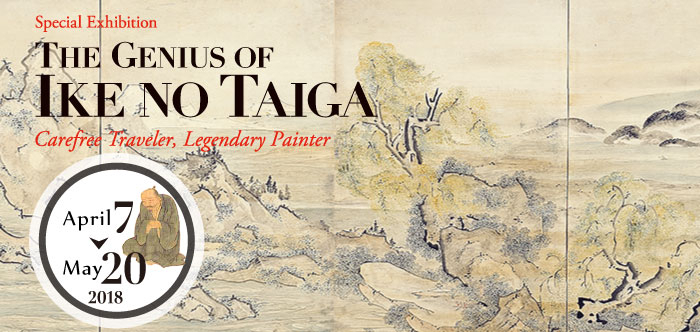
![National Treasure Landscape with Pavilions By Ike no Taiga Tokyo National Museum [on view: May 2 - 20, 2018]](../../../jp/special/img/20180407/img_taiga_tmb.jpg)
